
The HPC booster: a compact cube full of energy. (Photo | ADS-TEC)
It looks rather unremarkable on the outside: A white cube, around 1.20 meters high, standing on a black base. A ventilation grille is recessed on the sides — also in black. The HPC Booster is reminiscent of an over-sized freezer. But under the lid of the 1.8 metric ton cube, there are no deep-frozen oven fries, but 320 kilowatts of concentrated charging power for electric cars. From zero to 80 percent in just a few minutes — this is fast and achieved easily by the HPC Booster and the associated charging station, the HPC Dispenser.
Power from the socket
The topic of e-mobility is advancing more than ever before. The range of electric cars is growing, along with demand. However, there are still too few charging stations in some European countries such as Germany. This is primarily due to high construction costs because most charging stations require access to the medium-voltage network, which involves first digging up roads and laying new power cables. Something which costs a lot of time and money.
“Every household could theoretically set up its own quick-charge station.” – Jannik Lorenz, ADS-TEC
However, with the HPC Booster from Nürtingen-based ADS-TEC, expensive expansion of the medium-voltage network is no longer necessary. The white power cube has its own energy storage system, enabling it to be connected directly to the well-developed low-voltage network that we all know from home. From there, the HPC Booster can store and pool energy, and transfer it quickly to a connected electric car via the HPC Dispenser.
“In theory, every household can set up its own quick-charge station in this way,” says Jannik Lorenz, PR specialist at ADS-TEC. “The HPC Booster impresses not only with its high performance when charging, but also with its compact design. This makes it unique as a quick-charge station.”
Clever cooling concept
However, high performance also means a lot of energy. And a lot of heat is generated wherever a lot of energy flows. This is no different for the HPC Booster and poses a particular challenge precisely because of its compact design. This is why the quick-charge cube has a clever cooling concept to ensure smooth operation. ADS-TEC also relies on technology from ebm-papst for this. Two EC centrifugal fans from the RadiCal series and a cooling unit ensure that cold air circulates constantly around the lithium battery block in the power cube.
The HPC Booster can be used to charge all common electric cars from 200 volts, as well as upcoming models with up to 920 volts.
Here, the cooling unit extracts heat from the battery block which must be dissipated to the outside. Two more EC centrifugal fans take over this task as condenser fans. This means that the HPC Booster can be operated without any problems at an outdoor temperature of up to 60 degrees Celsius — whilst the inside temperature never rises above 30 degrees Celsius.
Under these conditions, the white power cube can deliver top performance and charge around four to seven electric cars one after the other in conjunction with the HPC Dispenser. Here the quick-charge cube continues to draw energy from the low-voltage network and is practically never empty.

HPC booster and dispenser on site. (Photo | ADS-TEC)
In addition, another HPC Dispenser can be connected to the quick-charge cube to supply power to two electric cars at the same time. And it does this irrespective of the vehicles’ voltages. This is because the HPC Booster can be used to charge all common electric cars from 200 volts, as well as upcoming models with up to 920 volts, making the power cube the perfect quick-charge station for the future.
This was also recognized by a well-known German automotive manufacturer and a large energy supplier, who have invested in ADS-TEC’s quick-charge station. We will therefore certainly see the white power cube more often in the coming years at gas stations, car dealerships, and city centers.

Leave a comment